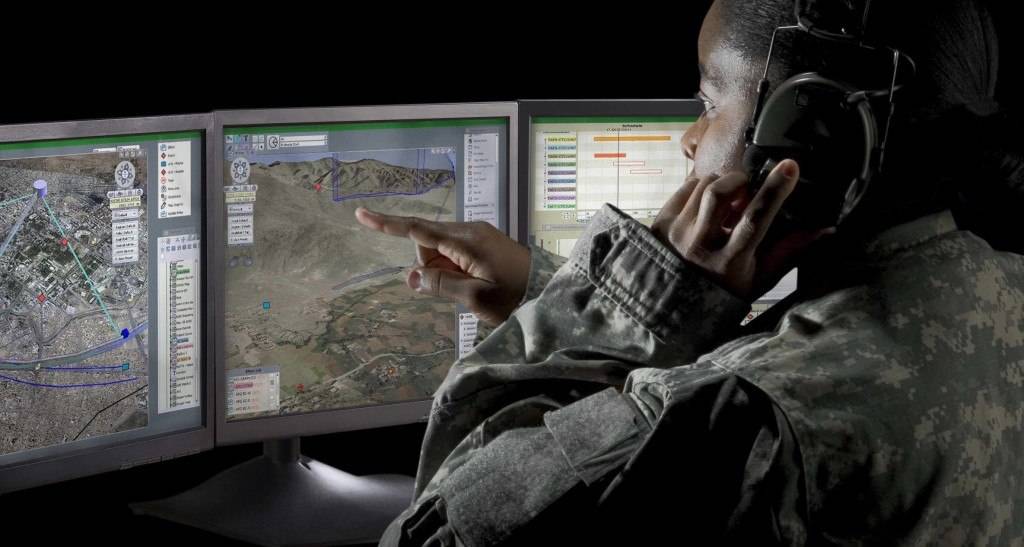
With more than 20,000 systems deployed or in use around the world, the Army’s collaborative support system has begun a three-phased approach that will sustain its current capabilities and then transition into a collaborative web environment that reaches across all echelons — and all devices.
This system, the Command Post of the Future processes and displays combat information onto digital maps from other Army systems at the battalion and above echelons, including from the Joint Battle Command-Platform, which allows Soldiers in vehicles to track friendly (blue) and enemy (red) forces, and the Advanced Field Artillery Tactical Data System, used for comprehensive fire support capabilities.
“CPOF revolutionized the face of the command post,” said Col. Michael Thurston, Project Manager for Mission Command. “It produced the technological leap from acetate maps to digital screens, and became the foundation for the advanced, collaborative technologies our Soldiers are using now or soon will be.”
These advanced technologies are part of the Army’s Command Post Computing Environment and Mounted Computing Environment, which consolidates capabilities using web-based apps and displays them on a common, geospatial digital map hosted on a single workstation or mobile device.

Command Post of the Future is moving to the next generation of mission command with Command Post Web, a web version of CPOF that provides similar capabilities to users with access to the Army’s tactical network. Photo Credit: U.S. Army
But first, PM Mission Command’s plan to sustain existing capabilities while fielding new ones includes assistance from two government organizations.
Beginning in fiscal year 2015, all earlier versions of CPOF up to 10.0 will move to the sustainment phase with the Software Engineering Center at Aberdeen Proving Ground. The SEC, part of the Communications Electronics Command, provides software support services to the command, control, communications, computers, intelligence, surveillance and reconnaissance community.
Meanwhile, Tactical Mission Command, part of PM MC, is managing new versions of CPOF up to the current release, but development efforts have shifted to the Weapons Systems Engineering Center out of Picatiny Arsenal, New Jersey.
“We chose the WSEC because of their superb past performance in building real-time safety critical systems code for our Fire Support Command and Control organization,” said Lt. Col. Shane Taylor product manager for TMC. “In teaming with both SEC and WSEC, we know that the final development efforts for CPOF, as well as the fusion of future capabilities, are in good hands.”
One of the more recent and critical enhancements to CPOF is the Disconnected, Intermittent, Limited function, which was recently evaluated at the Army’s Network Integration Evaluation at Fort Bliss, Texas. The NIEs feature Soldiers of the 2nd Brigade, 1st Armored Division who evaluate systems in a realistic operational environment.
DIL capabilities provide uninterrupted operations in the event of a network outage or the requirement to rapidly relocate a command post by allowing individuals and units to disconnect from the network, continue to conduct mission command operations using CPOF, and then reconnect and resynchronize with the data repository.
“We took lessons-learned from the last NIE to ensure this CPOF function operated without incident,” said Robert Monto, Technical Director for TMC, “At 15.1, Soldiers successfully disconnected and reconnected to the network numerous times within the scale and complexity of NIE’s vast, collaborative environment.”
By fiscal year 2019, CPOF functionality will transition to a web application based solution set, tentatively termed Tactical Applications. TacApps is TMC’s portion of CP CE (v3), and will merge several mission command capabilities onto one. In addition to CPOF, TacApps will include Command Web, the framework that supports web- app development; Battle Command Sustainment and Support System, which includes all of the logistics web apps; and Common Tactical Vision, an up-and-coming situational awareness capability that includes a DVR-like playback function.
# # #

